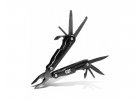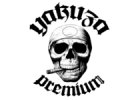


Product detailed description
Wakizashi - Aikuchi Japanese Sword Folded AISI 1075 Steel, Real Gunome Hamon
This blade is made of 1075 folded steel. The blade has been folded 11 times to create 2048 layers to increase the flexibility and hardness of the blade. The visible wavy grain on the blade is the result of repeated folding during forging. The production of this blade goes through 14 processes up to hand sharpening - the surface of the blade as a mirror. The blade has been hand polished with hazuya stone in the final stage - this achieves an almost razor sharp edge. Significant real Gunome Hamon is created according to ancient traditional methods based on the master blacksmith's years of experience. It is a top quality replica of a samurai sword that is suitable for sect trials and can be disassembled into its individual parts. This blade has been tried and tested to remove everything in its path ! The blade is in the form of a naoshi zukuri naginata, i.e. a halberd blade naginata that has been secondarily modified as a sword. In this case it would be a naginata of the type made by the early Muromachi period, i.e. by the 14th century. The blade has a beautiful, elegant shape, which thanks to the shrunken back of the oroshi mune geometry predisposes the sword to great cutting properties. The hamon line of partial tempering is in the form of gunome, evoking, for example, the Mino tradition within Gokaden.
Company Dellinger disclaims all liability for injury and damage resulting from use. Keep the katana out of the reach of children ! Any handling of the samurai sword is your own responsibility. Remember, you are holding a deadly weapon!
The blade is in the form of a naoshi zukuri naginata blade, i.e. a halberd naginata blade that has been secondarily modified as a sword or forged in this form. In this case it would be a naginata of the type made by the early Muromachi period, i.e. by the 14th century.
This wakizashi makes an ideal attractive pair of daisho with uchigatana, made in the same style. The blade has a beautiful, elegant shape, given by the focal point of the blade bending towards the handle (zori basket). The lighter, well-balanced blade has a geometry predisposing the sword to excellent chopping properties thanks to the shrunken back of the oroshi mune. A line of partial hardening, the hamon is in the form of a gunome, evoking, for example, the Mino tradition within Gokaden. The texture of the translating material (hada) is transparent (hada tacu), bordering on wavy masame to ayasugi. The material used is excellent Aisi 1075 steel.
Uchigatans in aikuchi design were also made in katana sword lengths, most often in the range of 60-70 cm. This type of sword was worn, for example, by the famous warrior Uesugi Kenshin (1530 - 1578). This type of sword was used both in battles with joroi armour as a supplement to the longer tachi sword, and with civilian clothing for self-defence. Although the design of the longsword without tsuba disappeared in the Edo period (1603-1868), tantō daggers and wakizashi swords continued to be made in this style. The handle of the tsuka is in the dashi zamé version, i.e. covered with stingray leather without braid (tsuka maki), the paired menuki ornaments with the plum tree sprig theme are therefore in the demenuki variant. The fitting of the end of the kashira handle and the end of the kodjiri scabbard made of brass (shinchu) is in the form of a kiku chrysanthemum, a symbol of long life. The rim of the fuchi hilt is with a theme of rafts and sakura flowers, with imitation gold and copper shakudo alloy , hallmarked with a "fish spawn" nanako pattern. Apparently, as with the menuki, it is a cast of a real historical original. The saya scabbard is covered with repainted and refinished rayskin in nuri zamé style, which looks very elegant. The sage-o-string that secures the sword to the obi belt is ivory in colour.
This is a highly crafted and fully functional replica of a samurai sword.
TECHNICAL DESCRIPTION:
| Total length of sword including sayi | 77,9 cm |
| Sword weight incl. sayi | 710 g |
| Sword weight without sayi | 500 g |
| Blade length | 54,4 cm (incl. Habaki 2.4 cm) |
| Type of blade | Naginata Naoshi Zukuri |
| Blade material | AISI 1075 folded |
| Blade thickness (for Habaki) | 0.6 cm |
| Blade height (for Habaki) | 2.6 cm |
| Blade thickness at the tip | 0.4 cm |
| Blade height at the tip | 2 cm |
| Hamon | real, Choji type |
| Habaki | brass (length 2,4 cm) |
| Tsuka (handle) | in dashi zamé, i.e. covered with stingray skin without braid (tsuka maki) |
| Saya (cloak) | covered with repainted and refinished rayskin in nuri velvet style. The sage-o braid that secures the sword to the obi belt is ivory in colour. |
Dellinger guarantee: Dellinger comes with a 100% satisfaction guarantee or risk-free money back guarantee. We guarantee an excellent product that will give you the best service. Each sword or katana is packaged in a deluxe sheath and can be a wise gift solution for a birthday, wedding or Christmas.
samurai sword warranty - examples of misuse
In general, these are all activities except for traditional chopping test techniques, which involve chopping into special mats.
- Cutting branches, trees and bushes: for this activity people have developed other tools such as axes or machetes.
- Chopping, or swordplay with another sword: destructive damage to the blade of a samurai sword - samurai avoided any direct contact with the enemy to avoid damaging the blade. The repair was long and expensive.
- Never wear a sharp samurai sword with the blade exposed in public: Always keep the sword sheathed in the Saye (scabbard). In Germany and other EU countries, this is even an obligation prescribed by gun law.
- Never insert a dirty blade into the Sayi: If you are performing chop tests on fruit, clean and preserve the blade immediately after chopping, otherwise the blade will rust and oxidize.
- Never leave your sword in a damp place such as a porch, shed, cellar or conservatory: This traditional weapon definitely does not deserve such treatment. Always clean the blade after use, brush with oil and store the sword in a dry place.

_-_edited.png)

































Be the first who will post an article to this item!
Only registered users can submit posts. Please log in or sign up.